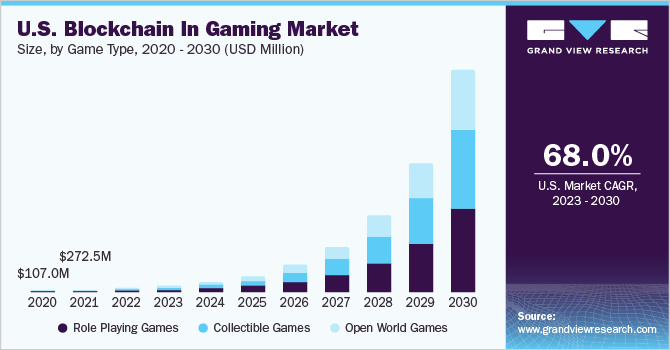The Web3 gaming market in the United States was valued at $4.83 billion in 2022 and is projected to exceed an annual growth rate of 68.3% between 2023 and 2030. However, if Web3 games are to meet these lofty projections, they must confront and overcome their most difficult challenge yet: gaining the unwavering love and loyalty of traditional gamers.

Many early Web3 games have faced criticism from prominent gaming enthusiasts for flaws such as shallow gameplay, scams, and declining asset values. New gamers are hesitant to join the fray because they don’t see value for their money and are turned off by the need for wallets, fees, and complex concepts like “digital collectibles.” Also, the publicly narrated negative experiences of existing participants worsen the situation.
Web3 gaming needs a fresh approach, one that can overcome the hurdles of compliance, appeal to the gaming majority, ensure economic stability, and still profitably leverage the power of digital currencies and NFTs.
In the spirit of rapid evolution, which is a hallmark of blockchain-based systems, a new model has been proposed to replace the once-revolutionary and prevalent model in Web3 gaming: Play-to-Earn (P2E).
This new model, “Mass Ownership,” seeks to address the inherent problems of the P2E model and boost adoption in the ecosystem.
We will discuss mass ownership in this article, along with the issues it needs to resolve in order to achieve and exceed the level of success of P2E games.
What is Mass Ownership, and How Does it Work?
Mass Ownership is intended to strike a balance between Web3 games’ promise of perpetual ownership and interoperability and traditional games’ sustainability and simple but engaging gameplay.
Web3 games use blockchains to create a public record of in-game assets, allowing players to own various game elements and use them across different games.
However, many early versions of these games faced challenges with sustainability and economic imbalances due to speculative behaviour and a focus on earning rather than engaging gameplay. Also, there was the issue of complex gameplay mechanics tied to the blockchain, which we could argue was a direct consequence of the way the system was designed.
A player’s interest in a game is primarily the fun derived from it. Early Web3 games successfully created a way to make players earn from this fun-seeking activity, but they lost sight of the fundamental reason for gaming. Mass Ownership restores this ideal while preserving the original innovativeness of Web3 games.
In addition to the concept of true digital asset ownership, which is a characteristic of many Web3 games, mass ownership introduces some other concepts to achieve its desired aims. These include:
- Separation of In-Game and Real-World Value: Digital assets in a game with a mass ownership model have no direct real-world value, which prevents price manipulation and ensures a fair gaming environment. The value is determined by the demand for them within the game.
- Player-Driven Liquidity: When players purchase in-game items with real-world currencies, the proceeds go directly to other players, creating a player-driven liquidity model. The consequence of this is the next key aspect of mass ownership.
- 3. Player-Controlled Economy: Players control the trading and pricing of the game’s digital asset. This creates a truly decentralized, player-driven marketplace. Not many Web3 games have this. Most in-game asset marketplaces always reflect the activity of some “investors” buying, selling, and holding the game’s native token.
Mass Ownership creates a player-driven in-game economy that makes players have a vested interest in the game’s success. It does this by shifting the focus of the players from the rewards they earn to the fun they get from playing the game.
Heroes of Mavia: An Example of Web3 Gaming Projects Adopting Mass Ownership
The Heroes of Mavia’s mass ownership model creates a player-driven economy centred around “Legendary Items.” These items are in-game assets built with Non-Fungible Token (NFT) technology. They include cosmetics, decorations, and consumables. They have a limited supply, but players can earn, trade, or purchase them using an in-game currency called “Ruby.”
Ruby cannot be bought or sold directly; it can only be earned through gameplay achievements, events, and challenges. This separates Ruby’s value from external market forces, preventing price manipulation and ensuring a fair gaming environment.
The true value of the Mass Ownership model lies in the Legendary Items themselves. As NFTs, these items are owned by players’ wallets, giving them complete control over their digital assets. Players can trade these items within the game’s internal marketplace using Ruby or on external NFT marketplaces for cryptocurrencies or fiat currencies, allowing them to realize real-world value for their in-game assets.
This model creates a player-driven marketplace where both free-to-play and NFT-owning players can participate and benefit. When players purchase Legendary Items from others using real-world currencies, the proceeds go directly to the players who earned or traded those items, creating a player-driven liquidity model.
Heroes of Mavia aims to balance player engagement and rewards by shifting focus from heavy reliance on monetary incentives to in-game assets like Ruby and Legendary Items. The goal is to create an environment where players are motivated by enjoyment and skill rather than just financial gains.
Can Mass Ownership Replicate the Success of Play-to-Earn (P2E) games?
While the Mass Ownership model promises to address many of the challenges faced by Play-to-Earn (P2E) games, its ability to replicate or surpass the success of P2E games will depend on several factors.
The initial success of P2E games can be attributed to the novelty of earning cryptocurrency through gaming and the potential for substantial financial rewards. However, the Mass Ownership model takes a different approach, focusing on creating an engaging gameplay built on a sustainable but player-driven economy within the game’s ecosystem.
One of the primary advantages of the model is its focus on delivering an engaging and enjoyable gaming experience, which has been a common criticism of many P2E games. By prioritizing gameplay over excessive monetization, mass-ownership games have the potential to attract and retain a broader audience of players who value an immersive and rewarding gaming experience.
Also, the decentralized ownership and player-driven marketplace aspects of the Mass Ownership model align well with the principles of Web3 and blockchain technology. By giving players true ownership and control over their digital assets, this model empowers players and creates a more equitable and transparent gaming economy.
Problems and Potential Challenges of the Mass Ownership Model
To replicate the success of P2E games, the Mass Ownership model will need to attract a significant player base by delivering a compelling and enjoyable gaming experience. The game’s mechanics, storytelling, and overall gameplay quality will play a crucial role in captivating players and fostering a loyal community.
Furthermore, the Mass Ownership model’s adoption and success will heavily depend on its ability to address its own set of challenges and potential problems:
Balancing gameplay and economy
Striking the right balance between engaging gameplay and a well-functioning in-game economy can be challenging. If the focus shifts too heavily towards the economy, it may detract from the overall gaming experience. This, in turn, creates the problem of attracting and retaining players. A game operating on the model will need to continuously innovate and provide compelling content to attract and retain a loyal player base, especially in this highly competitive gaming market.
Maintaining a sustainable economy
The success of the Mass Ownership model will heavily depend on its ability to generate sustainable revenue streams and maintain a vibrant in-game economy. While P2E games have demonstrated the potential for significant earning opportunities, the Mass Ownership model’s reliance on players trading digital assets within the game’s ecosystem may face challenges in terms of liquidity and market dynamics. Ensuring that there is enough demand and liquidity in the in-game marketplace to generate sustainable revenue streams for both players and developers could be a challenge.
Addressing potential exploitation
As with any system involving digital assets and trading, the Mass Ownership model may be susceptible to exploits, fraud, or other malicious activities. Robust security measures and monitoring mechanisms will be necessary to maintain the integrity of the in-game economy and protect players’ assets.
Adoption, Scalability and Performance
As the game’s player base grows, the blockchain infrastructure and in-game marketplace will need to handle increased transaction volumes and data loads efficiently without compromising performance or user experience.
On the other end, the industry-wide adoption of the model will be crucial for its long-term success. If only a few games embrace this model, it may struggle to gain traction and reach the critical mass necessary to attract a large player base and foster a thriving digital asset ecosystem.
Regulatory and legal considerations
Trading digital assets, even within a game’s ecosystem, may face regulatory scrutiny and legal challenges in certain jurisdictions. Navigating these complexities, as we have seen in many blockchain and crypto projects, will be crucial for the Mass Ownership model’s widespread adoption.
In Conclusion
Web3 games seriously need to find a balance between engaging gameplay and making the rewards tangible. The sustainability of the whole ecosystem depends strongly on prioritizing both player engagement and true digital asset ownership.
The mass ownership model seems to be a step in that direction. Nonetheless, it is crucial to recognize that the Mass Ownership model is still in its early stages, and its long-term viability and impact will largely depend on the collective efforts of game developers, players, and the broader Web3 community.
By embracing innovation, addressing challenges head-on, and continuously refining the model, the Mass Ownership approach could pave the way for a more sustainable and equitable future for blockchain gaming.
Disclaimer: This article is intended solely for informational purposes and should not be considered trading or investment advice. Nothing herein should be construed as financial, legal, or tax advice. Trading or investing in cryptocurrencies carries a considerable risk of financial loss. Always conduct due diligence.
If you would like to read more articles (and news reports and market analyses) like this, visit DeFi Planet and follow us on Twitter, LinkedIn, Facebook, Instagram, and CoinMarketCap.“ Take control of your crypto portfolio with MARKETS PRO, DeFi Planet’s suite of analytics tools.





















